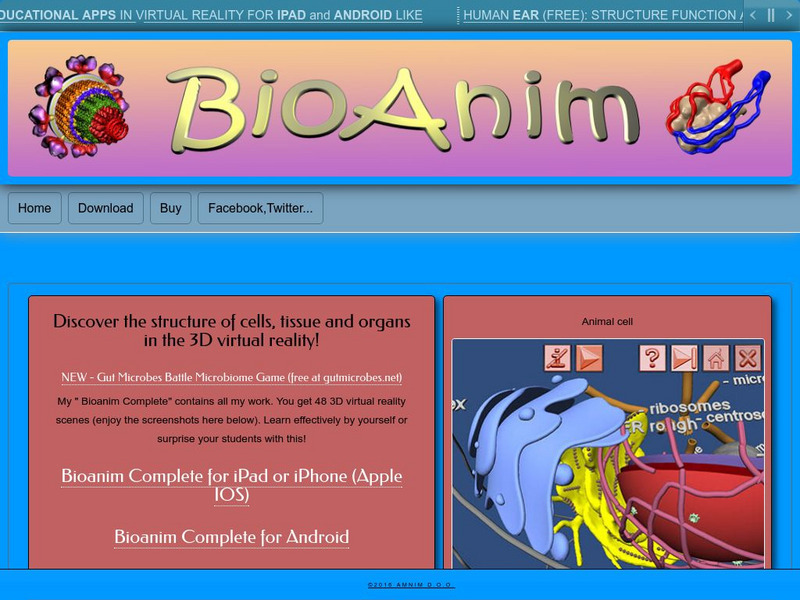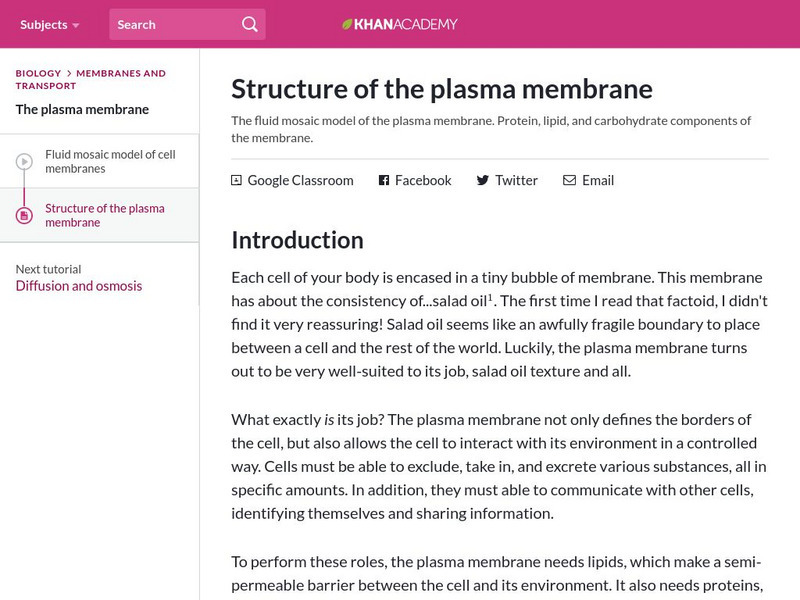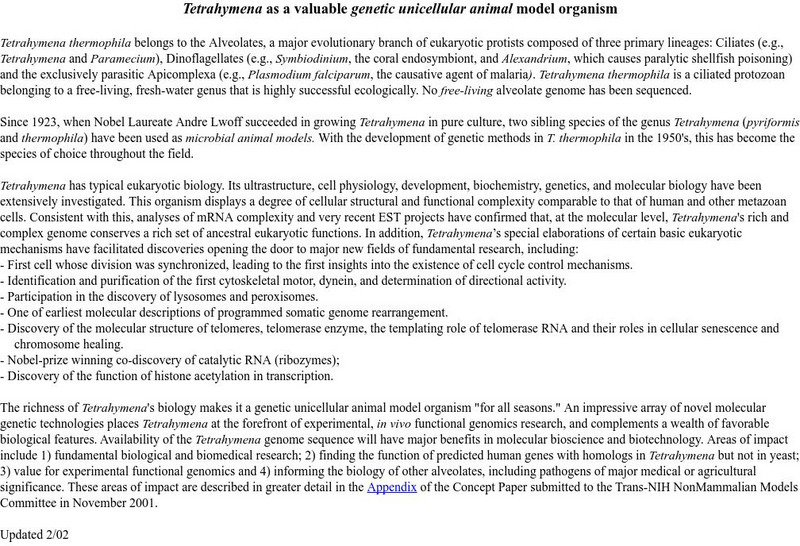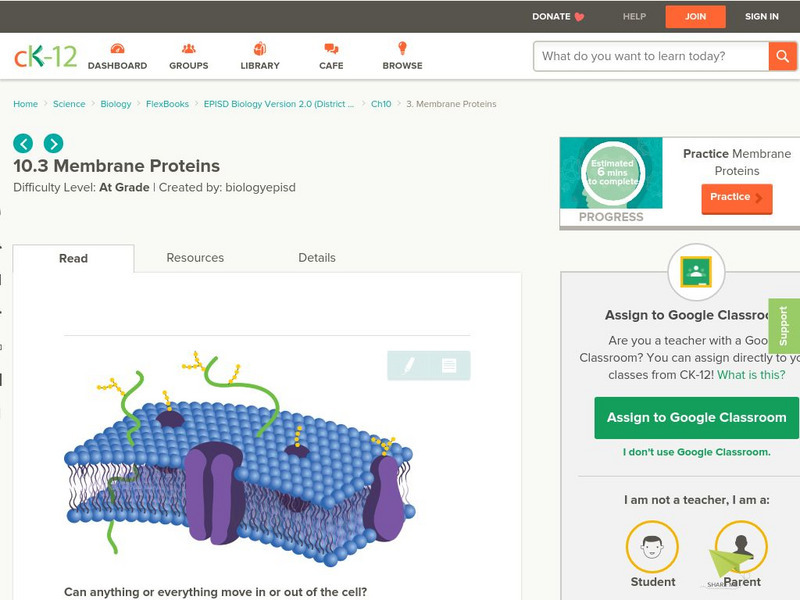Vision Learning
Visionlearning: Cell Biology: Introduction to Biological Membranes
Explanation of complex and dynamic cell structures that are selective in regards to what is allowed to enter and exit cells.
Other
Bio Anim
BioAnin presents 3-D labeled images of all of the major systems of the human body, for example, the digestive system and the endocrine system. The images are embedded in slideshows. The site also has interactive 3-D models that can be...
Enchanted Learning
Enchanted Learning: Plant Cell: Animal Cell Anatomy
This is a thorough site which contains a glossary of plant/animal cell anatomy terms. Diagrams of both cells are included along with worksheets to label.
ibiblio
Ibiblio: Virtual Cell Web Page
A teacher- and student-contributed website of 3-D models and explanations of cell structures.
Alabama Learning Exchange
Alex: Edible Cell
As part of the study on Life Processes, the young scholars will watch a video clip at Cells Alive to see a model of the cell and its components. The students will use edible products to create an animal cell. Each product will represent...
Ohio State University
Ohio State University: Cell Membranes
Diagrams and animations help you understand the basics of cell membrane structure and function.
BiologyWise
Biology Wise: Simple Steps on How to Build a Plant Cell Model
Describes the steps in how to make a model of a plant cell using simple materials and sweet foods like jello and candy.
Khan Academy
Khan Academy: Structure of the Plasma Membrane
Article takes a look at the different components (protein, lipid, cholesterol, and carbohydrate) of the plasma membrane, examining their roles, their diversity, and how they work together to make a secure boundary around the cell.
BiologyWise
Biology Wise: Guide on How to Make an Animal Cell Model
Describes the steps in how to make a model of an animal cell using simple materials.
Science Education Resource Center at Carleton College
Serc: Comparing the Simple Structure of Plant and Animal Cells
Students use guided scientific observation using a collection of models, visual material, and microscope slides to identify cell organelles. Then they demonstrate their understanding of the parts/characteristics of cells by identifying...
PBS
Pbs Teachers: Changing Your Mind: Nerve Cell Infomercials
Build nerve cell models in cooperative groups, and articulate the structure and function of nerve cells to explore the nervous system. Describe specific elements of human physiology by "advertising" the nervous system in nerve cell...
TeachEngineering
Teach Engineering: Cell Membrane Color Sheet and Build a Cell Membrane
Students color-code a schematic of a cell and its cell membrane structures. Then they complete the "Build-a-Membrane" activity found at http://learn.genetics.utah.edu. This reinforces their understanding of the structure and function of...
National Health Museum
Access Excellence: Travel Brochure for a Cell
This activity offers an alternative to cell models to help the students to understand cells and their functions. Students are required to produce a travel brochure that describes a plant or animal cell as if it were a large exhibit or...
National Health Museum
Access Excellence: Cells on a Ceiling
In this lesson plan site, each student is assigned a cell part to research, create, and place inside of a clear plastic drop cloth (the cell) the size of one-half of the classroom ceiling.
University of California
Tetrahymena as a Unicellular Model Organism
Information on Tetrahymena thermophila and why it is an important unicellular organism.
BiologyWise
Biology Wise: Tips on How to Make a Plant Cell Model
Describes the steps for making a model of a plant cell in two different ways. The first way uses mostly sweet foods and the second way uses a shoebox, clay, and simple materials.
BiologyWise
Biology Wise: Fluid Mosaic Model
The fluid mosaic model provides an explanation of the structure of biological membranes. It explains why a membrane can perform all of its functions, e.g., permeability and adhesion. This resource describes the main components of a cell...
TeachEngineering
Teach Engineering: Active and Passive Transport: Red Rover Send Particles Over
Students compare and contrast passive and active transport by playing a game to model this phenomenon. Movement through cell membranes is also modeled, as well as the structure and movement typical of the fluid mosaic model of the cell...
BiologyWise
Biology Wise: Tips on How to Make a 3 D Plant Cell Model
Describes the steps in how to make a model of a plant cell using clay and simple materials found at home. Suggestions for variations are also given.
BiologyWise
Biology Wise: How to Make a 3 D Dna Model Project
Describes the steps for how to make a model of DNA using colored polymer clay and wire. Students will gain a good understanding of the structure of DNA by doing this project.
Other
Molecular Movies: 3 D Tutorials for Biologists
A collection of visualization-oriented tutorials for creating 3D animations for use in your biology classroom. Search by difficulty level, software package, or 3D topic area.
PBS
Pbs Teachers: Scientific American: Never Say Die: How to Make a Nose
Investigate breakthroughs in stem cell research, and explore the structure and function of a DNA molecule. Create a model of a DNA from tagboard.
BiologyWise
Biology Wise: Peripheral and Integral Membrane Proteins
Discusses the structure of a cell membrane, the role of membrane proteins, and the differences between integral membrane proteins and peripheral membrane proteins as regards to their functions, location, and relationship with the...
CK-12 Foundation
Ck 12: Membrane Proteins
[Free Registration/Login may be required to access all resource tools.] Activity explores proteins in the plasma membrane describing their structure and function. The Fluid Mosaic Model is also summarized.














